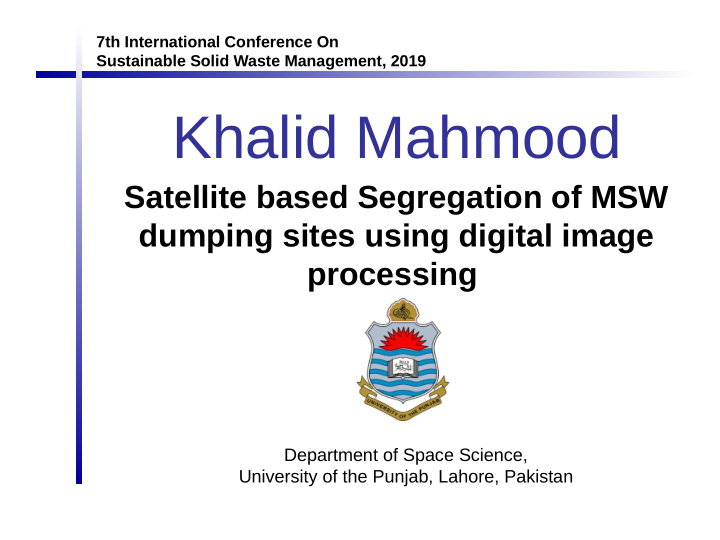



7th International Conference On Sustainable Solid Waste Management, 2019 Khalid Mahmood Satellite based Segregation of MSW dumping sites using digital image processing Department of Space Science, University of the Punjab, Lahore, Pakistan
Contents Study Objective Study Area Material and Methods Results and Discussions Conclusions
Study Objective The primary goal of this study was to develop a computer based model for auto identification of Municipal Solid Waste (MSW) dumping sites and segregation of its different units on the basis of the age of dumped waste to facilitate the decisions and the potential development of better environmental management strategies.
Study Area Faisalabad has been taken as the main study area, having two open dumps of MSW. • MF-MSWOD • NF-MSWOD Figure 1: Study area
Extension of the Study Area To elaborate the difference of spectral response for different dumping facilities the study area has been extended to include two dumps from another city named Lahore. So finally we have considered four of the open dumping sites. Figure 2: Extended study area
Material and Methods Data of Landsat-8 satellite has been used (149, 038). Image has been cut to study area, such that all the major land covers should be included in it. Figure 3: Subset of Landsat-8 image for identification of MSWODs
Material and Methods Visible, Near InfraRed (NIR) and Midle InfraRed (MIR) bands of the satellite image were stacked together, followed by zonal statistical operation. Keeping in view the spectral response patterns a detailed spectral sampling has been done for residential areas and soil patterns to accommodate all the possible variations in the spectral signatures mixing or contributing to MSW dumps. Unsupervised classification with varying number of landcover classes has been done in order to discriminate MSW dumps from other landcovers.
Material and Methods CLASSIFICATION This process was initiated with 30 spectral classes using ISODATA algorithm, performed 15 iterations having 0.99 convergence threshold. Number of classes were then gradually increase for a better class discrimination representing dumps as a separate spectral class from other landcover features. Maximum 50 spectral classes were developed with the same number of iterations and convergence threshold. Classes identified as MSW dumps were merged to get a representative spectral signature.
Results and Discussions Figure 4: Image classified in to 30 classes, where MSW dumps fall in two classes
Results and Discussions Figure 5: Image classified in to 40 classes, where MSW dumps fall in four classes
Results and Discussions Figure 6: Image classified in to 50 classes, where MSW dumps fall in four classes
Results and Discussions Spectral Response Comparison of Different Landcovers Reflectance Values 12500 MF-MSWOD 11500 NF-MSWOD 10500 MB_MSWOD Vegetation 9500 Soil 8500 Reidential 7500 6500 1 2 3 4 5 6 7 Spectral Bands Figure 7: Spectral signature of various land covers
Results and Discussions Spectral Signatures of Residential Area Reflectance Values 10000 9500 9000 8500 8000 7500 7000 1 2 3 4 5 6 7 Spectral Bands Figure 8: Range of spectral signatures for residential area
Results and Discussions Spectral Signatures of Soil 1E+04 Reflectance Values 1E+04 1E+04 1E+04 9E+03 8E+03 7E+03 1 2 3 4 5 6 7 Spectral Bands Figure 9: Range of spectral signatures for soil
Results and Discussions Spectral Signature of Dumped MSW Reflectance Values 10500 MF-MSWOD-1 10000 MF-MSWOD-2 MF-MSWOD-3 9500 NF-MSWOD MB-MSWOD 9000 Saggian 8500 8000 1 2 3 4 5 6 7 Spectral Band Figure 10: Spectral signature of dumped MSW at different dumps
Conclusions Remotely sensed satellite data can be use as an alternative to ground surveys for studying open dups of MSW This study can provide a basic understanding of the process and based on the information obtained model can be improved for proper identification and age wise segregation of MSW open dumps. These improvement may include development of suitable band ratios can also help to highlight minor differences between spectral signatures of mixing landcover and to produce contrast of the dumps. Another possibility raised is the use of thermal bands with temporal combination rather than spectral combinations. This study recommends the use of high resolution satellite data in context of both spatial and spectral resolutions for the development of preliminary models of identification.
Thank You
Recommend
More recommend